In the digital era, content is king, and its best ally? Technology. Artificial Intelligence has emerged as a game-changer in shaping the future of content writing. Within this world of creative possibilities lies an array of software applications designed to aid your every word-crafting need. You might be familiar with the Byword – a favored tool amongst many writers. However, while it offers significant features, there are more options available that could better suit specific needs or preferences. Intrigued? Willing to explore what lies beyond Byword? Sit tight! In this guide, I’ll tour the finest Byword alternatives to enhance your AI content writing journey in 2024.
What is Byword AI?
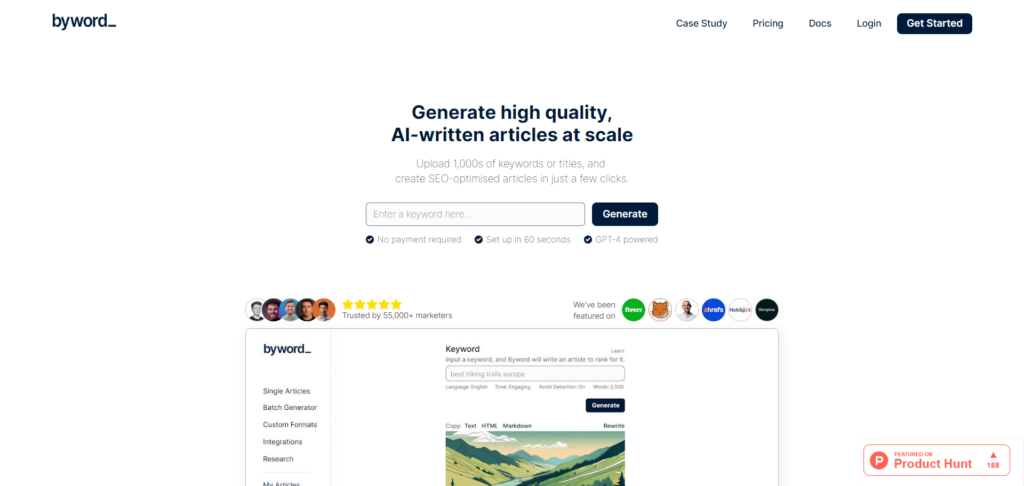
Byword is an AI-driven content creation tool that leverages the power of artificial intelligence to provide an efficient and streamlined process for generating high-quality, SEO-optimized content. By distinction, Byword stands out by catering specifically to producing long-form articles. It utilizes the latest advancements in AI technology, including the capabilities of ChatGPT-4, to create content that is well-written and strategically structured to perform well in search engine result pages (SERPs).
Byword AI Main Features
Byword has a rich array of features designed to streamline the content creation process and enhance the end product. These features include:
- AI Integration: By embodying the latest AI algorithms, Byword facilitates the creation of content that is not only original but resonates with the target audience. The integration of AI also extends to editing tools, ensuring the content is polished and error-free.
- User-Friendly Interface: Navigating through Byword is a breeze, thanks to its intuitive design. The platform also offers a range of customization options, allowing users to tailor their workspace according to their preferences.
- Analytics and Reporting: Tracking content performance is crucial, and Byword offers comprehensive analytics. Users can easily monitor how their content is performing and make data-driven decisions to enhance their strategy.
- Content Creation Features: Byword supports generating various content types through many tools, such as templates, collaboration features, SEO optimization assets, and workflow management capabilities.
- Integration Capabilities: Whether it’s CMS compatibility or external platform integration, Byword ensures a smooth flow of content across different ecosystems, enhancing efficiency and flexibility in the content creation.
- Batch Content Generation: Byword’s batch generation capability is a boon for those eyeing expansive content strategies. It accommodates the production of hundreds of articles, streamlining efforts to populate or update a site’s content library rapidly.
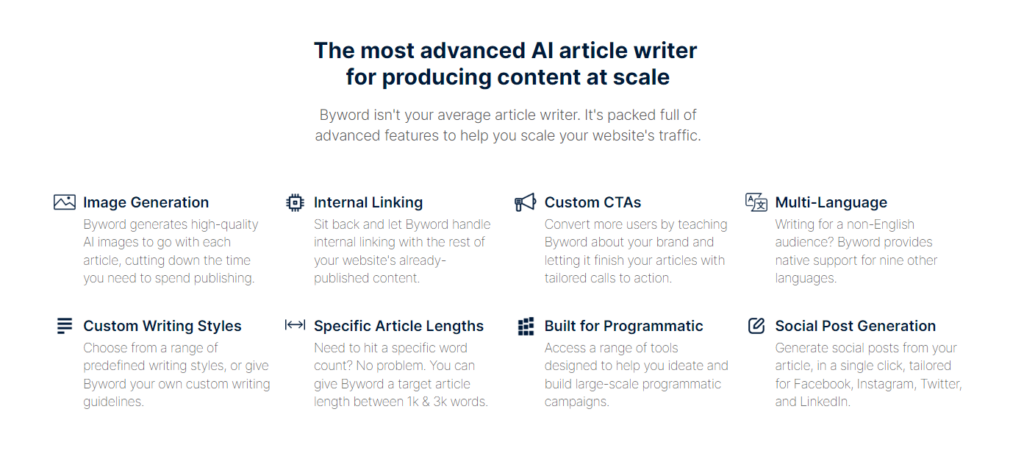
These features adeptly address the challenges faced in content creation, from ideation to publication, making Byword a compelling choice for those seeking to optimize their content production process.
What do people think of Byword? Byword AI reviews
Evaluations of Byword reveal a mix of perspectives, highlighting its strengths and areas where it could improve.
Byword AI Pros
- Quality and SEO-Oriented Content: Users appreciate the high quality of SEO-optimized content that Byword generates, significantly reducing the need for post-creation adjustments.
- Convenient Features: The variety of tools available, especially AI image generation and batch article generation, are lauded for their contribution to streamlining the content creation.
- Affordability: Many users find Byword’s pricing model, including the pay-as-you-go option, cost-effective, especially considering the quality of output it delivers.
- AI Images: Accompanies every article with a uniquely generated AI image, adding visual appeal.
- The ability to create content based on keywords, titles, or structured headings caters to varied needs.
- No restrictions on word count, promoting exhaustive exploration of topics.
- The platform’s programmatic builder and batch generator are instrumental in building topical relevance at scale.
Byword AI Cons
- User Interface: Some users find the interface too simplistic, lacking the visual appeal that can enhance the user experience.
- Limited Editing Tools: The absence of a built-in content editor limits the ability to fine-tune articles within the platform, requiring users to use external tools for further editing.
- Content Format Restrictions: The generated content sometimes lacks sufficient bullet points or whitespace, affecting readability and requiring manual adjustments for better formatting.
Why Users Might Look for Byword Alternative
One compelling narrative prompting users to seek alternatives revolves around the case of Casual.app – which is a flagship Byword case study. The Casual.app initially leveraged Byword to amass significant online traction, engaging in large-scale programmatic SEO campaigns. This strategy propelled them to over a million organic sessions monthly, establishing a substantial digital footprint.
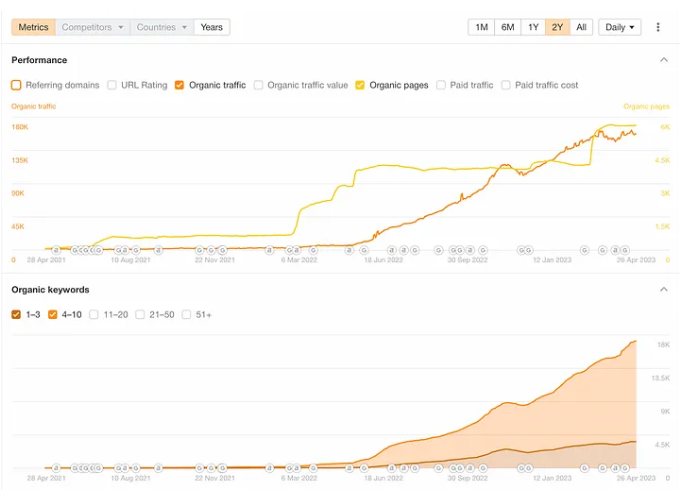
However, this achievement came with a caveat. The approach, heavily reliant on AI to rewrite existing competitors’ content, needed the addition of unique value. Consequently, it drew scrutiny for employing methods deemed as skirting ethical content creation standards. The pivotal moment arrived towards the end of 2023 when the Casual.app faced a penalty, a stark reminder of the risks associated with overdependence on AI for content generation without substantial human input or oversight.
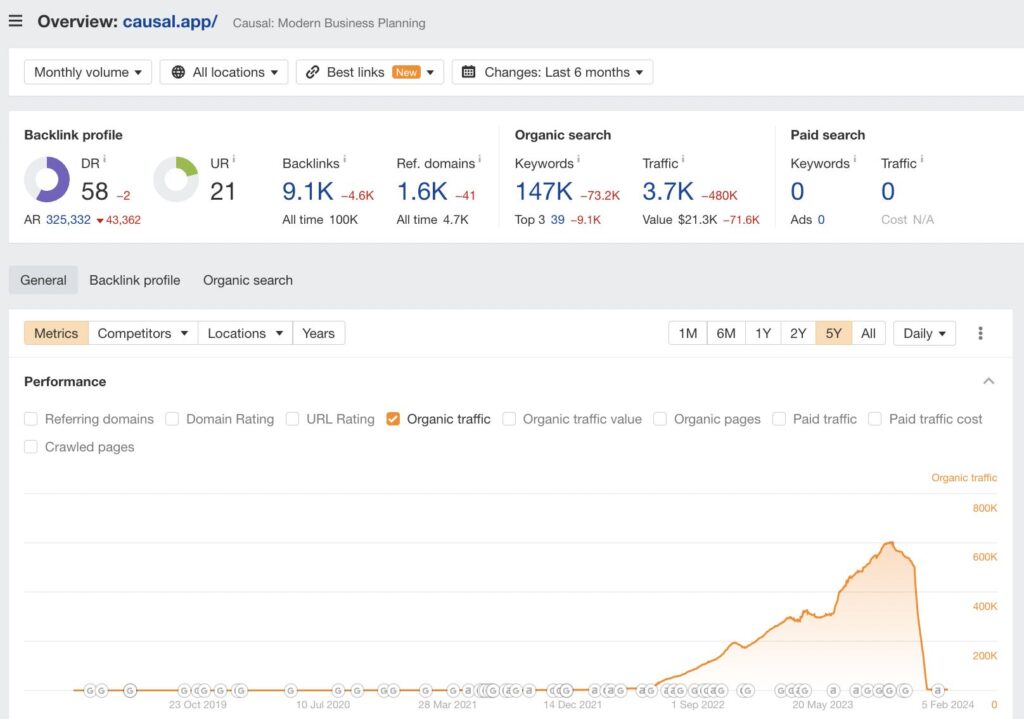
This episode is an instructive case for those using Byword or similar AI content tools. It accentuates the importance of blending AI-generated content with human creativity and expertise to ensure that the output resonates with search engines and upholds the standards of originality and added value. That’s why we are strong supporters of CyborgMethod™.
What other features users might be looking for?
Despite its robust features, there are reasons why users might seek alternatives to Byword:
- Preference for a More Interactive Interface: Users looking for a more visually engaging and interactive content creation platform might explore other options that offer a richer user interface.
- Need for Detailed Instructions and Customization: Those requiring a tool for more detailed instructions before the content generation process may find Byword’s capabilities limiting.
- Lack of in-depth content and keyword research: Those looking for competitor data and user questions may find the information available on Byword not sufficient to make data-driven decisions.
- Desire for More Comprehensive Editing Features: For users who prioritize having extensive editing tools within the content creation platform, the absence of these features in Byword may be a drawback.
Byword presents a compelling option for specific content creation needs, especially in producing SEO-optimized articles efficiently. Still, individual preferences and requirements might drive the search for alternatives that align with specific expectations and workflow demands.
In the following sections, we dive deeper into these alternatives individually, examining them from various perspectives to help you decide if you might find a tool more appropriate for your needs beyond Byword.
Which Byword Alternative is Right for You? A Guide to the Selection Process
Embarking on the journey of choosing a content writing tool can feel daunting, even more so when confronted with numerous Byword alternatives. Though these options offer dazzling features and promise substantial results, how do you zero into the one that fits your unique needs, like a glove in hand?
Let’s take an insightful stroll through a selection process to help streamline your decision-making.
Step 1: Understand Your Specific Needs. Get clear on what you require from a content-writing AI tool. Do you need it primarily for SEO optimization or enhancing overall readability? Are you looking for the simplification of complex ideas or just impressive copywriting?
Step 2: Budgeting: While selecting an alternative to Byword, consider your financial limitations. Premium tools come with comprehensive benefits but often carry hefty price tags.
Step 3: Ease Of Use: Choose an AI content writing tool offering intuitive interfaces and user-friendly processes. This will save time spent struggling over complexities rather than concentrating on creating high-quality content.
Step 4: Customer Support: Check whether the platform provides responsive customer service. Whichever option you choose should be able to address any issues promptly, ensuring minimal disruptions.
Step 5: Research User Reviews & Testimonials: – Riding on other users’ experiences can give valuable insights about product performance.
No size fits all while fishing out your perfect Byword equivalent. Therefore, diligently tallying each alternative against these parameters will lead you closer to making an informed choice that suits your curation agenda.
What are the Best Byword Alternatives and Competitors?
As a writer seeking to improve your productivity or as an entrepreneur, you might look for a valuable Byword alternative. You might need advanced features such as AI-powered language correction, SEO tools, or even content-writing algorithms that can generate human-like text. This is where other tools come into play as noteworthy alternatives, offering distinct features tailored to various needs.
I will look into exploring some of the top-notch Byword alternatives available:
- SEOwind: Ideal for those targeting search engine optimization within their content.
- ChatGPT: A solution provided by OpenAI that aids in generating creative articles.
- Content Harmony: Excellent for planning and executing keyword-driven content strategies.
- Copy AI: Suitable for businesses, its value lies in crafting compelling marketing copies leveraging AI.
- Dashword: Strikes gold for users seeking key insights from competitor content.
- GrowthBar SEO: An apt choice for comprehensive SEO data on Google’s search results page.
- Jasper (previously Jarvis): If automation is your deal – Jasper offers prolific auto-writing capabilities alongside SEO optimization functions.
- Sudowrite: Perfect match for fiction writers or fantasy storytellers powered with AI suggestions and improvements in real-time.
- Surfer SEO: For all-in-one management of web content – Surfer SEO also provides a comparative analysis of competing pages online.
- Writesonic: A resourceful tool with features ranging from blog idea generator to grammar fixer.
Remember, though, determining whether these options will suit you better depends on specific requirements and personal preferences regarding ease of use, diverse function offerings, and budget considerations.
Now, let’s examine what each offers their users and how they stack up against Byword.
SEOwind
As we dig deeper into the world of AI content writing, I’d like to introduce you to an alternative that has been impressing experts and newbies alike – SEOwind. Developed by practitioners deeply vested in SEO, content marketing, and artificial intelligence (AI), this software rises above its contemporaries for a compelling reason: it empathizes with the user’s requirements.
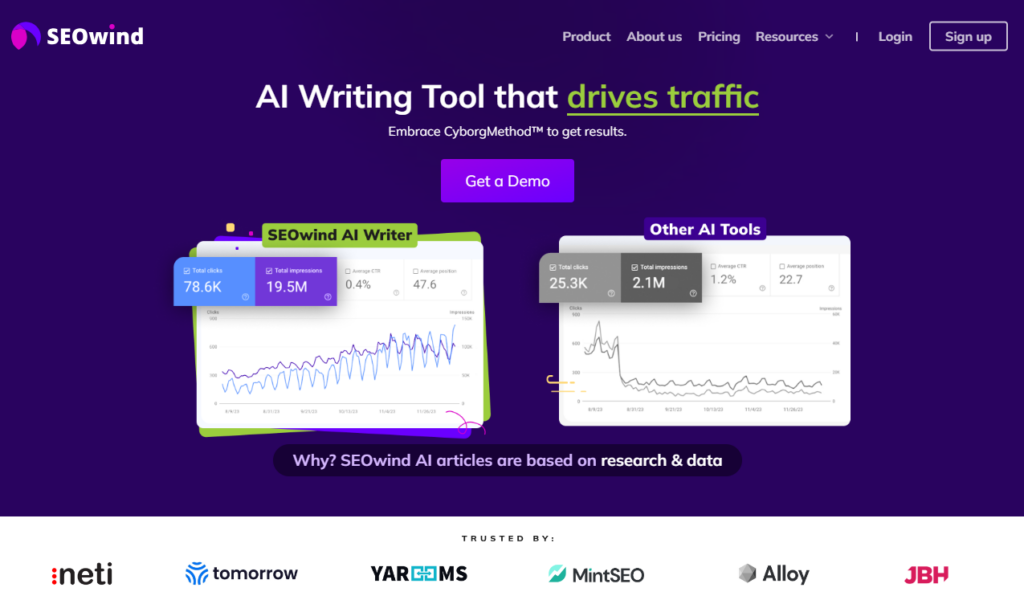
Why Choose SEOwind as a Byword Alternative?
Selecting between Byword and SEOwind can be challenging. However, some factors tilt the scale in favor of SEOwind. It creates long-form, human-like content based on comprehensive SEO data and research while preserving your unique brand voice. You get high-quality articles and blog posts with minimal input from you.
SEOwind applies artificial intelligence judiciously throughout each process, improving efficiency without compromising personalization, something Byword cannot match up to. Its ethos is rooted in CyborgMethod™, a belief system encouraging cooperation between humans and AI for superior results.
Furthermore, I want to draw attention to its multilingual potential—an aspect often overlooked by other platforms but not by SEOwind! Delivering support for 12 languages, including English, Spanish, French, and German, offers an undeniable edge, expanding formidable horizons!
SEOwind Key Features
Delving into specifics sets apart good alternatives from great ones.
- In-depth Content and Keyword Research: SEOwind conducts SERP analysis, providing you with insights about top-performing content: their word count, content outlines, and user questions.
- Powerful AI built-in: Lets you use AI to draft a content outline, title, description, keywords, and AI article draft.
- SEO-optimized articles: AI article drafts written with SEOwind cater not only to the reader but also to search engines.
- Brand Voice Customization: This enables you to define tone and audience demographics, ensuring personalized output remains unique.
- Multi-language Support: Writes in 12 languages, proactively catering to global audiences.
SEOwind Pros
While I could go about listing all the possible pros of using SEOwind over Byword, these particular advantages need special recognition:
- Controlled AI involvement ensures content feels human while remaining efficient and research-backed.
- Offering multilingual support dissolves language barriers and enables global accessibility.
- It’s designed to learn, adapt, and customize your brand voice for unbiased writing.
- An in-depth SEO strategy fortifies ranking capabilities.
- Overview of top-performing content with an easy way to draw conclusions.
For Whom is SEOwind best for?
SEOwind caters to a wide array of users encompassing content marketing domains. It excels at producing long-form written material like articles and blog posts; anyone requiring these types of content will find it invaluable.
With its SEO-centric approach, the service particularly shines for businesses seeking to increase their digital footprint—boosting online visibility through improved keyword presence. So, suppose you’re an entrepreneur, marketer, or blogger focusing on generating engaging, high-quality, continuous content while taking advantage of cutting-edge AI technology. In that case, you’ve found your perfect match in SEOwind.
Remember that tools are necessary, but selecting the right tool customized to requirements elevates output quality. Keep exploring alternatives until you get fit!
Let’s continue exploring the best Byword alternatives!
ChatGPT for Article Writing
As content creators seek top-of-the-line tools to amplify their writing prowess, one emerging Byword alternative is the GPT-4 powered tool – ChatGPT by OpenAI. This language prediction model has gained rapid popularity among AI-driven writers for many reasons that we’re about to dive into.
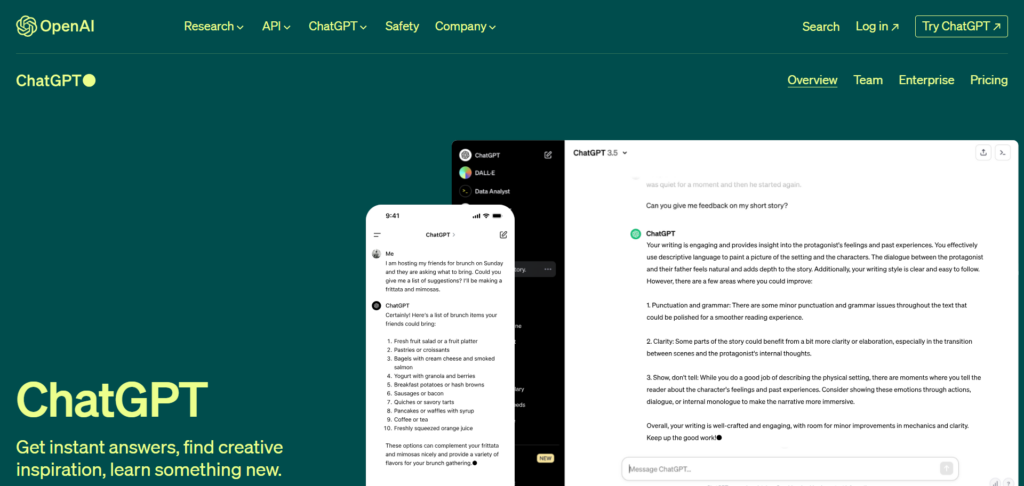
ChatGPT Features
ChatGPT offers numerous features designed to enhance your copywriting experience and productivity:
- Autocomplete: The system automatically suggests completions while you’re typing, saving valuable time.
- Drafting Assistance: It assists in drafting emails or other pieces of text, enhancing productivity and quality.
- Content Generation: Able to generate creative content like poetry, essays, or short stories.
- Translation: Translate languages efficiently with a better understanding and nuance than traditional translation tools.
These effective features and machine learning capacities present profound possibilities for advanced content production.
What is ChatGPT Best For?
Not all writing tools serve every task equally well, but what sets ChatGPT apart is its breadth of utility. Being built on GPT-4 technology enables it to master both formal assignments and casual discussions:
- It’s highly skilled in producing professional marketing copy or drafting technical reports.
- It creates human-like dialogue, making it an excellent choice for role-playing or scripting dialogues.
- Writes compelling blog posts complete with appropriate creativity and logical structure.
- And acts as a virtual assistant during brainstorming sessions – suggesting innovative ideas.
I recommend ChatGPT if you’re looking for diverse functionalities backed by robust AI capabilities responsibly deployed.
Byword vs. ChatGPT: 3 Key Distinctions in Article Writing
1. Purpose and Focus
Byword is engineered with a laser-sharp focus on streamlining the process of creating SEO-optimized long-form content. It doesn’t attempt to be a jack-of-all-trades; instead, it zeros in on providing a solution for generating articles ready for publication and search engine indexing. Byword empowers users to input keywords or titles and, within minutes, receive a polished draft complete with an AI-generated image.
On the other hand, ChatGPT offers a broader range of functionalities within text generation, extending beyond just article writing. From constructing code snippets to engaging in conversational text, ChatGPT’s versatility makes it a multi-use tool. However, this generalist approach means that while it can assist in drafting articles, it lacks the specialized features for SEO optimization and doesn’t produce ready-to-publish content as directly as Byword does.
2. User Experience and Interface
Byword presents a straightforward and minimalist user interface designed to expedite the article creation process with minimal distractions. Its simplicity, however, may feel too basic for users accustomed to more visually engaging platforms. But this bare-bones approach aligns with Byword’s goal of delivering quick and efficient content creation solutions.
In contrast, ChatGPT offers a nuanced interaction model catering to varied textual tasks, particularly when accessed through platforms that augment its capabilities. The interface of these platforms generally provides more guidance and options to tailor the AI’s output, accommodating a more comprehensive array of tasks beyond article writing. This complexity affords flexibility at the expense of Byword’s one-click simplicity for generating long-form content
3. SEO Optimization and Publishing Ready Content
A critical advantage of Byword lies in its inherent ability to produce high-quality and SEO-optimized content. This makes Byword particularly valuable for users looking to enhance their online visibility without the extensive manual tweaking often required after having an initial draft with general AI writing tools.
ChatGPT, while adept at generating informative and coherent text, does not natively factor in SEO considerations during the writing process. Users may need to employ additional tools or manual efforts to optimize ChatGPT-generated articles for SEO purposes, adding steps to the content creation workflow.
The choice between Byword and ChatGPT hinges on specific needs: For those prioritizing SEO-optimized, publication-ready long-form content, Byword offers a streamlined, focused solution. ChatGPT, with its versatile capabilities, caters to users requiring AI assistance across a broader range of textual tasks, albeit with a potentially higher input for article optimization and refinement post-generation.
Content Harmony
In our search for the best Byword alternatives, we landed upon a potent AI-driven tool named Content Harmony. The following few sections delve into its features, ideal usage scenarios, and how it compares with Byword.
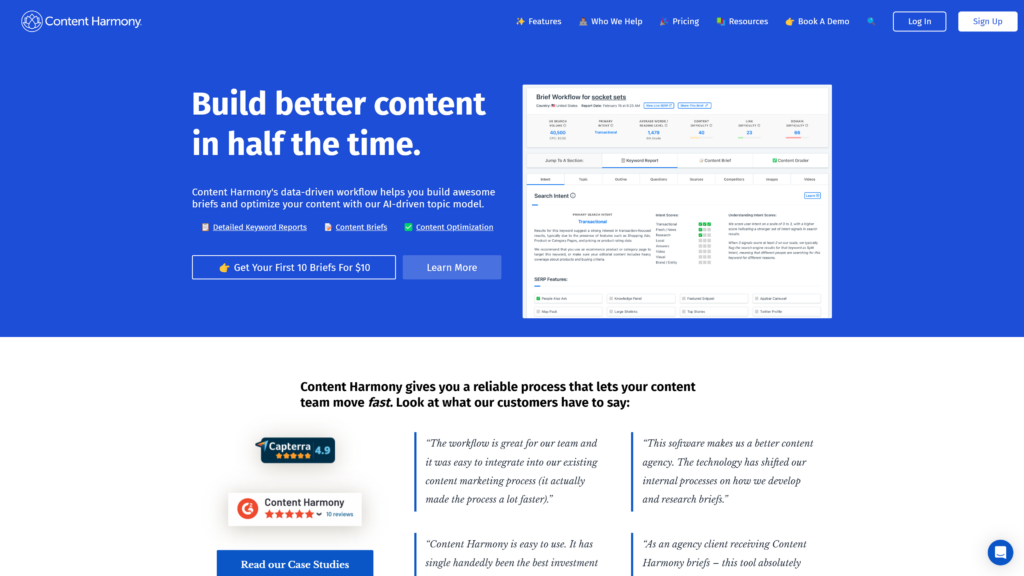
Content Harmony Features
Content Harmony is more than just an alternative to Byword. It’s a game-changer in AI content writing. It presents distinct and impressive features:
- Intelligent Keyword Research: Using frequency and relevance algorithms, this feature helps users pick relevant keywords within minutes.
- Content Brief Creation: Powered by AI, this tool can swiftly generate well-detailed content briefs using data from top-performing content across various platforms.
- Competitor Analysis: Market research is made easy as you can monitor your competitor’s marketing strategies and learn from their successes (and failures).
- SERP Analysis: The Search Engine Results Page (SERP) analysis generates insights about who ranks high on your keywords and why.
The robustness of these features makes Content Harmony a strong contender in the current generation of AI writing systems.
What Is Content Harmony Best For?
Content Harmony shines best when used by digital marketers, SEO specialists, blog writers, or anyone looking to sculpt data-driven web copies based on intelligent keyword research and SERP analytics.
Its integrated approach allows for a seamless transition between keyword research and copywriting stages, which saves precious time. Meanwhile, its detailed competitor analysis add-ons deliver the strategic advantage that every online business seeks today.
So, if making informed decisions quickly while churning out quality web content sounds like your daily mission, then Content Harmony might be just what you need!
Content Harmony vs Byword: 3 Key Differences
Each software brings unique features to the table, catering to various needs in the content creation landscape. Let’s dive into three critical differences between these tools, shedding light on how they can serve your writing endeavors.
AI Integration
Byword leverages cutting-edge artificial intelligence to streamline the content creation process significantly. Its AI capabilities enable it to rapidly produce high-quality content, catering to users who need to generate large volumes of articles efficiently. Byword’s AI also extends to editing tools, ensuring your content is polished and refined with minimal effort.
Content Harmony, on the other hand, focuses more on optimizing content for SEO while ensuring the creative touch isn’t lost. It integrates AI to offer suggestions for improvement. Still, it significantly emphasizes human input, ensuring the AI complements the creative process rather than taking it over. The tool is excellent for creators looking to balance AI efficiency and personal touch.
User Interface
The user interface of Byword is designed with simplicity in mind, ensuring users can navigate its features effortlessly. Its intuitive dashboard offers a straightforward pathway to accessing its extensive functions, from AI-generated content creation to analytics. This simplicity makes Byword an excellent choice for individuals or teams looking for a no-fuss solution to content creation.
Content Harmony adopts a more detailed approach in its interface, providing users with many tools to enhance content strategy, such as keyword analysis and SEO optimization suggestions. The interface caters to users who prefer having an array of options for each aspect of content creation. However, this might come with a steeper learning curve.
Analytics and Reporting
Byword offers robust analytics and reporting features that allow users to track the performance of their content effectively. It provides insights into how articles perform, helping users make informed decisions about their content strategy. This aspect is invaluable for users prioritizing data-driven content creation, allowing for optimizations based on performance metrics.
Conversely, Content Harmony prides itself on offering detailed SEO analytics, focusing on optimizing content for better search engine rankings. It goes beyond general performance metrics, deepening into SEO specifics such as keyword ranking and backlink analysis. This makes Content Harmony an ideal tool for users whose primary goal is enhancing their content’s SEO performance.
In essence, both tools offer significant advantages for article writing, with their distinct features catering to different aspects of the content creation process. Understanding these nuances will help you pick the tool that best aligns with your content creation goals and strategy.
Copy AI
Automation within content creation has seen a revolutionary shift in recent years, with one such product making noticeable waves – Copy AI. This online platform uses artificial intelligence to generate engaging, conversion-focused copy with unmatched speed and efficiency.
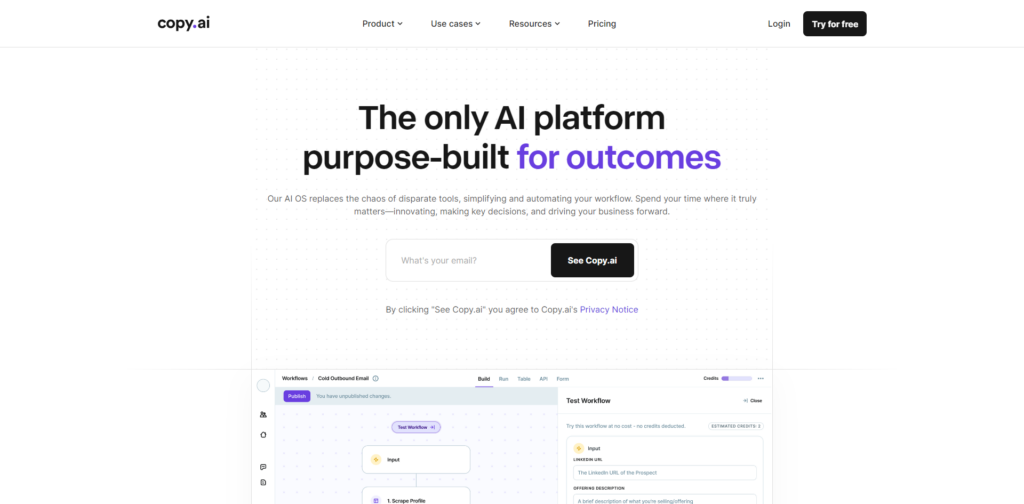
Copy AI Features
Copy AI utilizes advanced natural language processing algorithms to deliver high-quality text in diverse formats. Here’s what it brings to the table:
- Multiformat Content Generation: From advertising headlines, social media ads, and blog introductions to email subject lines, their AI engine can do it all.
- Contextual Relevance: It considers subject matter relevance, ensuring that the generated content is contextually correct on the money.
- Collaboration Tools: Users can work on projects together, giving rise to brainstorming ideas and sharing feedback on generated content.
- Tone Modifications: You can adjust the tone of your text, whether you want it to be casual or professional.
This tech-savvy tool turns creative hiccups into masterful compositions at lightning-fast speeds compared to traditional human copywriting methods.
What is Copy.ai great for?
Copy.ai shines brightest when it comes to generating business-centric texts like ads, website copy, or social media posts, where speed, consistency, and scale are crucial. Take a routine task such as drafting multiple emails for marketing campaigns, thrust this responsibility into Copy AI’s hands, and witness its incredible prowess while maintaining your brand voice and story continuity effectively.
Racing past writer’s block? Count on Copy.ai for its quick turnarounds, allowing you more time to focus on designing strategies rather than getting stuck in text composition obsession for overly long periods!
Copy AI vs Byword: 3 Key Differences
Now, let’s spotlight three main differences between these two writing powerhouses:
User Experience and Interface
The simplicity and minimalism of Byword’s interface cannot be overstated. It’s designed for those who appreciate a clutter-free environment that prioritizes the writing process above all. The tool keenly focuses on providing a seamless experience for writing, with less emphasis on the bells and whistles accompanying AI-enhanced functions. This makes it ideal for writers who prefer a straightforward, distraction-free writing session.
In contrast, Copy.ai offers a more feature-rich interface tailored to leverage AI capabilities fully. The platform is intuitive, making accessing various AI-driven writing tools from the dashboard easy. This includes options for generating content ideas, optimizing for SEO, and more. For users looking for a comprehensive tool that integrates advanced AI features directly into the writing process, Copy.ai shines brightly.
AI Capabilities and Content Generation
Byword leverages AI to facilitate the writing process, focusing on enhancing human input rather than replacing it. Its AI integration is subtle, offering assistance in grammar correction, sentence structure improvements, and style suggestions. The tool is adept at fine-tuning content but relies on the user to drive the creative direction of the article.
Copy.ai, on the other hand, Copy.ai is deeply rooted in AI-driven content creation. It goes beyond mere assistance to offer comprehensive article-generation capabilities. From crafting entire sections based on a keyword or title to generating creative marketing copy, Copy.ai is built to produce ready-to-use content with minimal human intervention. It’s a power-packed tool for those looking to speed up content production significantly while still maintaining quality.
Collaboration and Workflow Management
Byword focuses on the individual user experience, providing tools and features that cater to solo writers. This singular focus allows for a streamlined workflow tailored to personal productivity. However, it does mean that Byword lags behind in collaboration features, making it less suitable for teams or projects requiring multiple stakeholders’ input.
Reflecting the contemporary teamwork and collaborative efforts trend, Copy.ai integrates robust features designed for team collaboration. It allows multiple users to work on articles simultaneously, offers commenting and version tracking, and provides a platform for shared content creation goals. This suite of tools makes Copy.ai an excellent option for agencies, content teams, and businesses looking to co-create content efficiently.
These three key differences underscore the varied capabilities and focus areas of Byword and Copy.ai in the article writing domain. As you consider your needs—whether simplicity and focus are your priorities or if you’re leaning towards AI-driven content creation and collaboration, these distinctions will help guide your tool choice for enhancing your content creation process.
In comparing the two solutions side-by-side, it’s clear each caters particularly well to the specific needs of content creators and marketers, respectively – affirming that there just isn’t one fit-for-all formula when selecting between Byword Alternatives!
Dashword
Dashword is yet another remarkable addition to the cohort of Byword alternatives. Not only does it stand as a powerful content-writing tool, but its features also stretch into the realm of SEO research and keyword data gathering.
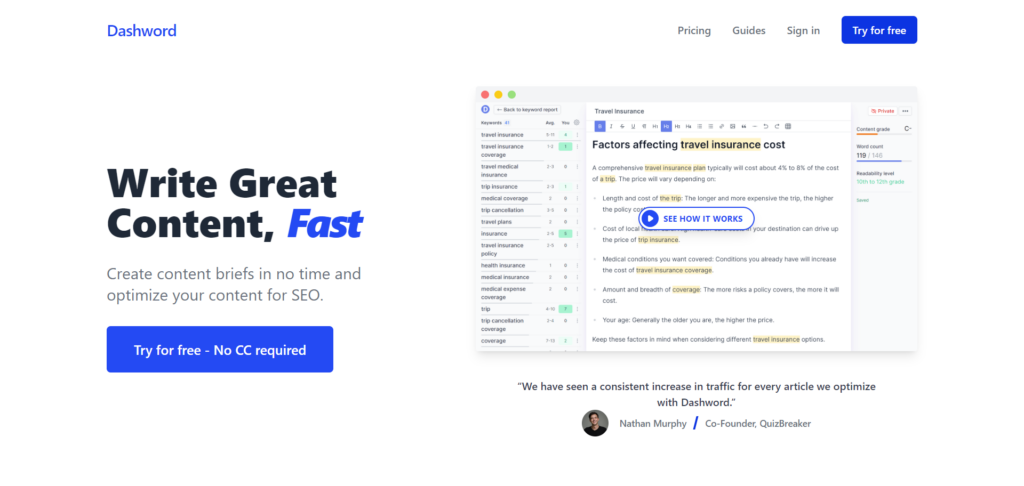
Dashword Features
Allow me to paint a vivid picture of what Dashword has in store for you:
- Data-driven Content Briefs: Armed with this tool, you can create meticulously informed content briefs using data. This is particularly handy when writing SEO-relevant content.
- Content Scoring: Dashword scores your drafts based on their potential SEO impact. You’ll know precisely how well you’re faring against competitors for any keyword.
- Topic Research: The platform ushers in extensive options for topic research, making it easy to plan your content ahead.
But remember, every application brings unique strengths and pots of gold at the end of different rainbows.
What is Dashword Best For?
Suppose I were to shine a spotlight on areas where Dashword truly excels. In that case, it’s top-notch for creating and curating effective SEO strategies. In particular, it shines bright when handling bulk-grade content projects or managing team workflows around SEO-oriented content marketing.
Similarly, marketers looking for applications that deeply integrate with their overall marketing approach will find an ally in Dashword because of its robust reporting and tracking functionalities.
Dashword vs Byword: 3 Key Distinctions
As we compare dashboards across these platforms, let’s take note of three vital distinctions between them:
AI Integration
Byword.ai leverages AI algorithms to generate content and provide enhancement tools that refine the writing. This dual approach allows for a seamless transition from creation to perfection.
While equally invested in AI for content generation, Dashword focuses more on optimizing content for SEO, using AI to suggest improvements based on keyword analysis and competitor content. Dashword’s AI integrates seamlessly with SEO analysis, providing real-time adjustments for more robust search engine visibility.
User Interface
The interface of Byword.ai is intuitively designed, making navigation simple for novice and experienced users. Collaboration tools within the interface enhance the ease of team projects. Customization features ensure users can tailor their workspace to their preferences, elevating the overall user experience.
Dashword offers a streamlined user interface that prioritizes content optimization tasks. Although user-friendly, it places less emphasis on customization and collaboration features. The focus on straightforward content analysis means Dashword’s interface is highly efficient for SEO-based writing but may lack the depth of interactive tools in Byword.ai.
Analytics and Reporting
Byword.ai excels in providing comprehensive insights into content performance with detailed analytics. This allows users to make informed decisions based on concrete data. The custom reporting features offered by Byword.ai are sophisticated, enabling users to track the success of their content through various metrics.
Dashword emphasizes content optimization analytics, focusing on how well content performs in search engines. Reporting is more tuned toward SEO metrics. While it provides valuable data, Dashword’s analytics are streamlined for SEO purposes, potentially offering less depth in other performance areas than Byword.ai.
Deciding the right choice between these Byword alternatives, whether Dashword or another, is about weighing your unique needs against each platform’s offers and finding the tool that best resonates with your tastes.
GrowthBar SEO
In your quest for the best Byword alternatives, discovering GrowthBar SEO should feel akin to finding a hidden gem. GrowthBar SEO is more than just an alternative to Byword; it’s an exceptional marketing and search engine optimization toolkit that goes hand-in-hand with content creation.
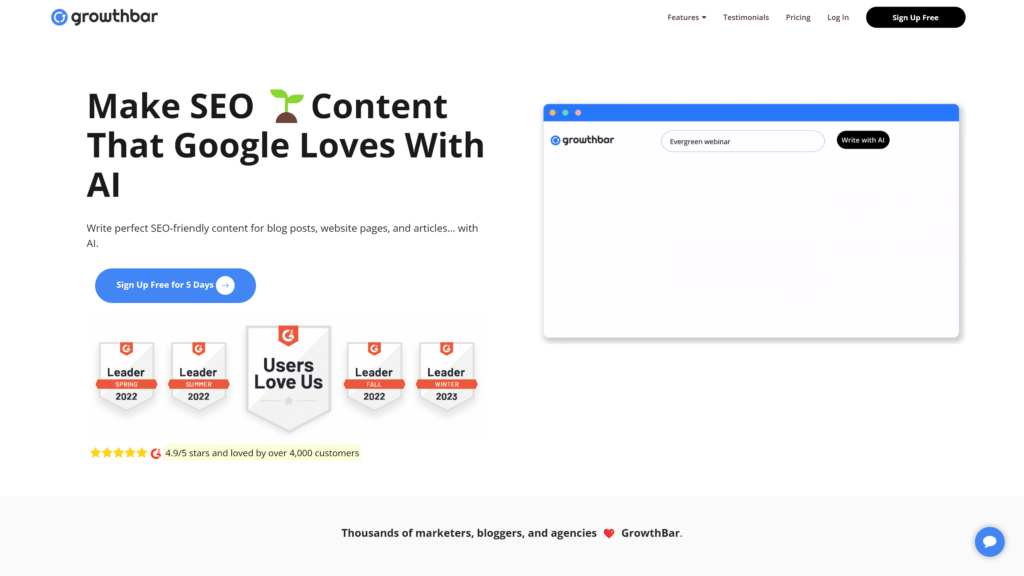
GrowthBar SEO Features
GrowthBar takes pride in offering a plethora of handy features clustered around data-driven content creation:
- Keyword Research Tool: This versatile tool focuses on long-tail keyword suggestions, assisting you in honing your content towards more organic traffic.
- SEO Metric Dashboard: It presents crucial metrics like domain authority and backlinks per page at a glance, helping you monitor your website’s overall health.
- Content Outliner: With its AI-enabled capabilities, this feature aids in structuring your blog or article efficiently.
- Competitor Analysis: It grants insights into how rivals are faring, enabling informed strategies for one-upmanship.
What is GrowthBar Best For?
GrowthBar is designed particularly for three main sectors:
- Bloggers looking for data-enhanced writing tools,
- Marketing specialists hungry for competitor analytics,
- Content strategists using sophisticated outlining tools.
Nonetheless, any professional looking to improve online visibility through effective search-engine-optimized content would find tremendous value within GrowthBar’s expansive offerings.
GrowthBar SEO vs Byword: 3 Key Differences
While both can be impressive platforms in their respective niches, understanding these key distinctions will help determine if transitioning from Byword to GrowthBar benefits you:
1. AI Integration and Content Quality
Byword leverages advanced AI algorithms, offering users unparalleled ability to generate high-quality content effortlessly. Its AI-enhanced editing tools further polish the generated content, ensuring it meets the highest standards.
While GrowthBar incorporates AI to streamline content creation, its primary focus is keyword optimization and search engine visibility. The content quality is reliable, but it might require more human intervention for stylistic or nuanced revisions compared to Byword’s outputs.
2. User Interface and Experience
With an intuitive dashboard and customization options, Byword ensures a seamless user experience. Its design focuses on simplicity, making navigation and the content creation smooth for beginners and professionals alike.
GrowthBar offers a straightforward interface focused on SEO tools and keyword research. While user-friendly, it targets users with a specific interest in optimizing content for search engines, possibly requiring a slight learning curve for those new to SEO.
3. Analytics and Reporting
Byword excels in providing detailed performance tracking and insightful data analytics. Users can keep a close eye on the success of their content, allowing for data-driven decisions to enhance their strategy.
GrowthBar’s strength lies in its extensive SEO analytics, offering deep dives into keyword rankings, search volumes, and competitive analysis. It is geared more towards SEO professionals looking to optimize their content’s search engine performance.
Evaluating these substantial differences, it’s apparent that GrowthBar SEO can extend beyond being simply an alternative to Byword. It may revolutionize your approach towards content creation holistically.
Jasper
Navigating the seas of content creation can be daunting; allow me to introduce you to Jasper, a worthy consideration on our voyage through Byword alternatives.

Jasper Features
As one of the newest AI-powered writing tools, Jasper brings many features to enhance and streamline your content production process.
- Adaptable AI Writer: This tool incorporates GPT-3 technology that generates human-like text and adapts itself based on your instructions and style preferences.
- Templates: Need to knock out a quick social media post or craft an engaging blog? With numerous pre-designed templates for various content types, producing quality work has never been easier.
- SEO Optimization: Who doesn’t love enhanced visibility in the digital world? And with built-in SEO advice baked into Jasper’s capabilities, you’re sure to reach wider audiences.
- Multi-language Support: For the international creatives among us, you’ll appreciate that it’s not limited to English; it supports over 20 other languages!
Now, let’s dig deeper – what is Jasper particularly good at?
What is Jasper best for?
If you identify as someone who routinely deals with short-form content like product descriptions, ad copies, or social media posts – then perfect news! You’ve met your match in Jasper. The tool shines when crafting catchy and concise text pieces.
But why stop there? If longer-form content like blogs is more your beat, relax. With the help of structured outlines provided by Jasper, creating detailed articles becomes almost effortless!
Whether you’re a business owner looking to bolster their brand presence digitally or a freelance copywriter crunched on deadlines, meet your new best friend, Jasper.
Jasper vs Byword: 3 key differences
All right then! Time for comparison; here are three noticeable areas where underlying contrasts come into play between Byword and Jasper:
1. AI Integration and Content Quality
Byword.ai uses advanced AI algorithms for generating content and refining drafts with AI-enhanced editing tools. This dual approach ensures the creation of high-quality content and its subsequent polishing.
Jasper, in contrast, emphasizes a more straightforward content-generation process. While it too uses AI for content creation, the emphasis leans more towards generating content drafts that might require additional manual editing to perfect.
2. User Interface and Collaboration
The Byword.ai platform is meticulously designed to optimize user experience. Its intuitive dashboard simplifies navigation and includes collaboration tools that facilitate team projects, making it an excellent choice for content creation teams.
Jasper adopts a different approach by focusing on a clean, user-friendly interface that prioritizes straightforward content generation. Although user-friendly, it may not offer the same collaboration tools and customization as Byword.ai, potentially making it more suited for solo writers or smaller projects.
3. Analytics and Performance Tracking
Byword.ai offers robust analytics and reporting features, enabling users to monitor the performance of their content comprehensively. This functionality is vital for users who rely on data-driven strategies to adjust and refine their content creation efforts.
Jasper also provides analytics features, but they are generally more basic in comparison. Users looking for detailed insights and data analysis might find Byword.ai’s tools more aligned with their needs.
So there we have it! Now, I’m not saying one is better than the other. Each brings different strengths and appeals to different needs. But if superior AI power, enhanced SEO capabilities, and multi-language support tickle your fancy, add Jasper to your list of contenders! After all, choosing the right content creation tool is akin to choosing the right travel companion – you need someone (or something) that complements and enhances your journey.
👉To dive deeper into how Jasper differs from Byword, go to our comprehensive comparison of Jasper versus Byword AI. This includes a current overview of functionalities, pros and cons, cost, and G2 scores.
Sudowrite
Sudowrite, which has become increasingly popular amongst writers and content generators, is another worthy contender in the alternatives to Byword. Let’s dive into what this tool is about: its unique features, optimal use cases, and how it compares with Byword.
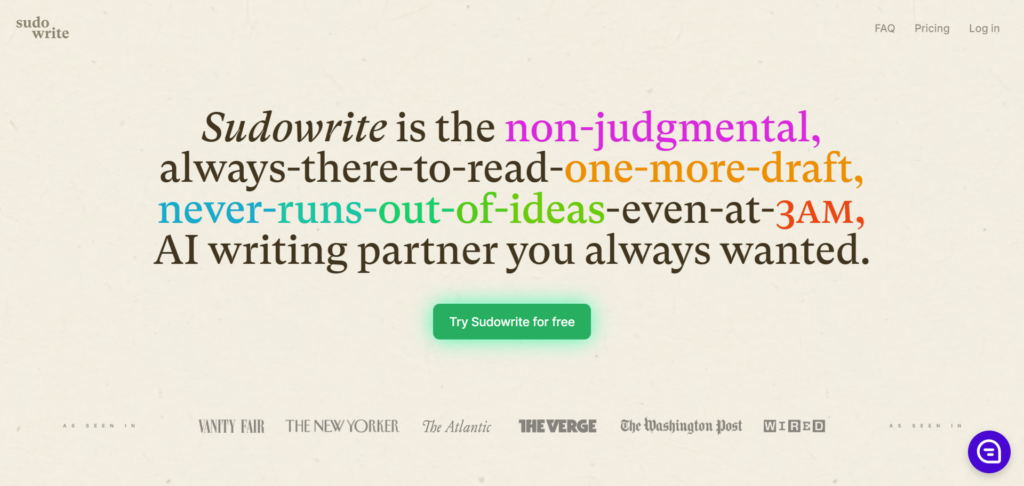
Sudowrite Features
- AI-Powered Writing Assistant: Sudowrite uses artificial intelligence to give you suggestions for enriching your text. It helps in enhancing your sentences while maintaining your original idea intact.
- Deeptext Models: With its advanced deep text models, Sudowrite understands context better than other tools and provides relevant improvements accordingly.
- Multiple Language Support: Unlike other platforms, Sudowrite supports various languages, making it accessible to a broader audience base.
This platform offers more than just grammar checks. Whether you are stuck or just looking for a new way to express yourself, Sudowrite can assist you.
What is Sudowrite Best For?
The diversified capabilities of Sudowrite make it well-suited for content creators across various domains.
Primarily,
- Bloggers who want to enhance their writing style will find the AI suggestions highly beneficial.
- Journalists and editors can use it as an editing tool for professional articles.
- Students, on the other hand, can leverage this platform to improve their academic papers.
Simply put, if you frequently deal with words professionally or academically, Sudowrite can be undeniably handy.
Sudowrite vs Byword: 3 Key Distinctions
Now that we’ve got an understanding of what Sudowrit brings to the table let’s examine how it stacks up against Byword through three key differences:
1. AI Integration and Writing Assistance
Byword leverages state-of-the-art AI algorithms to generate content. It offers writing assistance features, including grammar and spell check, tailored writing suggestions, and a plagiarism checker. This comprehensive approach ensures your content is not just original but polished.
Sudowrite, on the other hand, emphasizes creative writing enhancements, providing users with suggestions for more vivid descriptions, rewriting options, and thematic suggestions. It targets writers seeking to enrich their storytelling and narrative flow rather than focusing purely on technical correctness.
2. User Interface and Experience
Byword’s interface is meticulously designed to ensure ease of navigation. The platform’s intuitive dashboard facilitates quick access to its features, from content generation to detailed analytics. Its emphasis on collaboration tools further enhances its appeal for team projects.
Sudowrite takes a minimalistic approach to its design, prioritizing a distraction-free environment that fosters creativity. The platform is tailored for individual writers seeking a seamless, intuitive writing experience. However, it may lack the in-depth customization and collaboration features of Byword.
3. Analytics and Reporting
Byword excels in providing extensive analytics and performance-tracking capabilities. Users can delve into comprehensive insights regarding their content’s reach and engagement, enabling informed decision-making. The ability to customize reporting further elevates its utility for marketers and content managers.
Sudowrite focuses less on the analytics aspect, with minimal reporting features. It prioritizes the creative process over the analysis of content performance. This approach suits writers more concerned with the art of writing than with content metrics and SEO optimization.
Choosing the Right Tool
The decision between Byword and Sudowrite hinges on your specific needs as a writer or content creator. Suppose you focus on producing high-quality, SEO-optimized content with a keen eye on performance analytics. In that case, Byword emerges as a robust choice. On the contrary, for writers prioritizing creativity and storytelling, Sudowrite offers an environment conducive to artistic expression, albeit with limited analytics capabilities.
Surfer SEO
Surfer SEO, an exceptional contender in this list of Byword alternatives, is a platform brimming with top-notch features. Content writers and SEO professionals admire it for its remarkable ability to enhance keyword optimization and make pages rank higher on search engines.
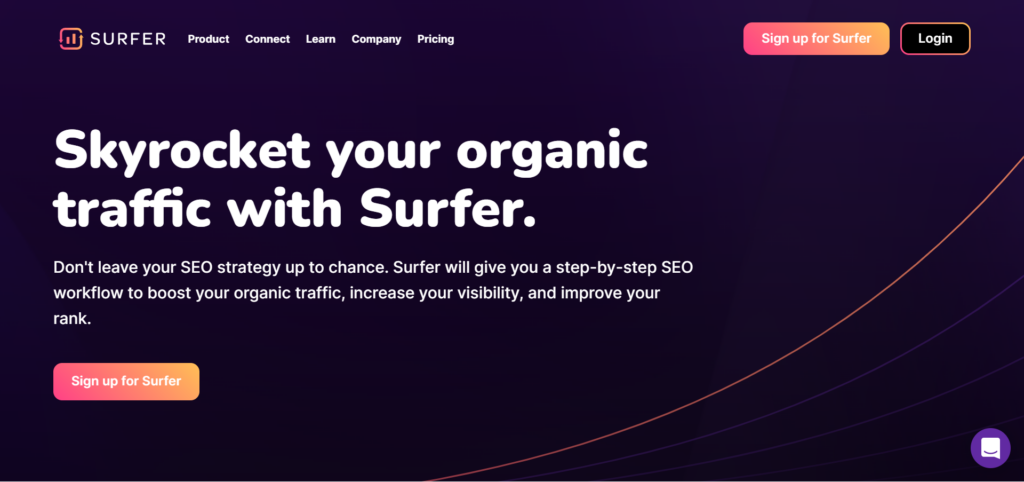
Surfer SEO Features
But what makes Surfer SEO stand apart? Here’s a quick run-through:
- Data-driven Content Editor: The tool uses AI to analyze top-performing competitor content and gives real-time tips. This helps you make your article aligned with algorithm preferences.
- Keyword Analyzer: This function lets you understand the ins and outs of selected keywords.
- SERP Analyzer: It shows how your page will compete against other sites’ rankings for the exact keywords.
- Customized Reports: Generate tailor-made reports to share with clients or stakeholders.
These features empower users to create result-oriented content shaded with keyword precision.
What is Surfer SEO Best For?
The essence of Surfer SEO lies in data-backed optimization techniques, ideally suited for the following personas:
- Content writers continuously work on improving their writing by aligning it with recent search engine guidelines.
- SEO Executives =dedicatedly working towards enhancing site rankings.
- And last but equally competent – Marketing agencies looking forward to impressively presenting their custom reports to clients.
In these segments, people find considerable value in adopting Surfer SEO as their everyday tool!
Surfer SEO vs Byword: 3 Key Differences
Transitioning away from Byword and moving towards Surfer SEO? Understand these three significant distinctions between both platforms:
1. AI Integration
Byword: Employs advanced AI algorithms for content generation, focusing on efficiently creating SEO-optimized, high-quality articles. It also provides AI-enhanced editing tools for a refined final product.
Surfer SEO: Primarily uses AI for SEO optimization rather than content creation. It analyzes content for SEO performance but relies more on user input for content generation.
2. User Interface
Byword: Boasts is an intuitive and user-friendly interface designed to streamline the writing and editing process for users of all proficiency levels. Collaboration tools for team projects enhance their usability.
Surfer SEO: Focuses on data analytics and SEO strategy implementation, offering a more technical interface. It’s optimized for SEO professionals looking to deep-dive into optimization metrics.
3. Analytics and Reporting
Byword: Offers detailed performance tracking and insights to measure content success, with customizable reporting features to suit individual needs.
Surfer SEO: Provides comprehensive SEO analytics, focusing on keyword strategies and content optimization to improve search engine rankings. Its reporting is heavily SEO-focused.
👉For an in-depth exploration of the differences between Surfer SEO and Byword, check out our detailed Surfer SEO vs Byword analysis. It offers up-to-date insights on features, pricing strategies, and G2 evaluations.
By understanding these differences, you can expertly decide whether shifting from Byword to Surfer SEO best aligns with your ambitions!
Writesonic
Unquestionably, Writesonic is esteemed in the galaxy of AI content writing solutions. Positioning itself as a sempiternal confidante for marketers, bloggers, and businesses alike, Writesonic is an innovative tool that engenders top-tier quality content effortlessly.
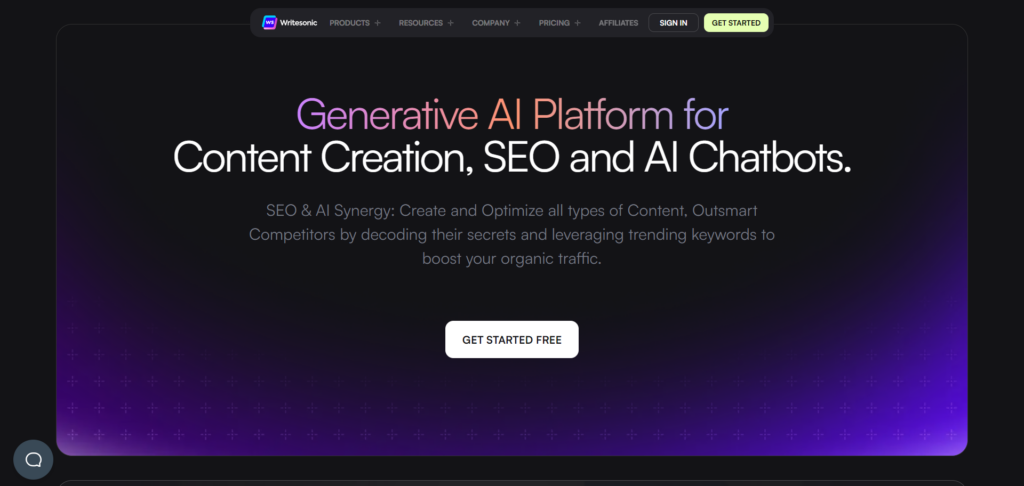
Writesonic Features
- AI-Powered Writing: Writesonic employs sophisticated AI algorithms to generate scroll-stopping text. This platform has you covered seamlessly, be it ad headlines, product descriptions, or blog post ideas.
- Landing Page Generator: Reduce time spent scratching down landing page text to minutes with their intelligent generator.
- Multi-Language Support: Mirroring Babel fish from The Hitchhiker’s Guide to the Galaxy, Writesonic understands and writes in 20+ unique languages.
- Content Rewriter & Enhancer: Not entirely pleased with your written piece? Storm through writer’s block by remodeling your existing content using their rewriter and enhancer tools.
Now, let’s look at what ideally brings people to this platform.
What is Writesonic Best For?
Writesonic radiates excellence when creating impactful digital marketing content – particularly ads, emails, social media copy, and SEO-enhanced blogs.
Bloggers will cherish its blog idea generator, while startups can swiftly leverage the power of their pitch deck builder. Given its multi-language capabilities, international businesses looking to expand their brand voice globally should seriously consider dipping their toes into what Writesonic’s waters offer.
Writesonic vs Byword: 3 Key Differences
But how does it size up against Byword? Let’s check three key distinctions between them:
1. AI Integration and Content Quality
Byword.ai integrates cutting-edge AI algorithms, positioning itself as a powerhouse for generating high-quality content. Its advanced AI-enhanced editing tools further refine content, ensuring that users can effortlessly create polished articles.
Writesonic also leverages AI to aid in content creation but significantly emphasizes speed and volume. The platform is known for its rapid content generation capabilities, enabling users to create drafts quickly. However, it may sometimes require more user intervention for content refinement than Byword.
2. User Interface and Ease of Use
The interface of Byword.ai is crafted with a focus on simplicity and user experience. Its intuitive design facilitates easy navigation, allowing even beginners to adapt quickly. The inclusion of collaboration tools also caters to team projects, enhancing productivity.
Writesonic offers a user-friendly interface that prioritizes functionality. It provides ample customization options and templates, making it conducive for users to generate content swiftly. However, its focus on functionality over simplicity can present a steeper learning curve for new users.
3. Analytics and Reporting
Byword.ai stands out with its comprehensive analytics and reporting capabilities. Users have access to in-depth performance tracking, enabling them to gauge the success of their content accurately. This data-driven approach assists in informed decision-making.
Writesonic includes basic performance tracking features but places more emphasis on content generation rather than in-depth analysis. Users looking for rudimentary insights will find value, though those requiring detailed analytics may find Byword’s offerings more robust.
While both Byword and Writesonic offer impressive features for article writing, their fundamental differences lie in the integration and depth of AI algorithms, the complexity of user interfaces, and the extent of analytics and reporting capabilities. Byword appeals to users seeking high-quality content with comprehensive analytics. In contrast, Writesonic caters to those prioritizing speed and volume in content generation.
FAQ Around Byword Alternatives and Competitors
You may have several questions as you scour the internet for a fitting alternative to Byword. Picking out the right content creation tool isn’t easy, so I’m here to illuminate some of your most burning queries.
What Apps Are Like Byword?
Many apps fall into the same category as Byword, providing an enriched environment for writing and editing.
- SEOwind is an AI-powered SEO tool that not only assists in generating content but also improves its quality aligned with SEO strategies.
- ChatGPT offers an interactive way to churn creative digital content, even if you are just starting in this realm.
- Dashword, quite similar to Byword, focuses more on SEO while helping writers create compelling blogs or articles.
- Tools like Jasper and Sudowrite use artificial intelligence algorithms to spruce up any given piece of writing.
- Both Copy.AI and Content Harmony come remarkably close to what Byword has to offer in terms of simplicity and efficiency.
Further down our guide, we delve deeper into these alternatives and outline their features, pros, and cons, everything you’d need for a comprehensive comparison to aid your decision-making process.
How Does Byword AI Work?
Byword employs advanced machine learning (ML) technology in its operation. It uses ML models trained over substantial textual data across multiple contexts and categories. This facilitates mirror-like text generation coherently with your input’s tone, style, and subject matter context.
As users input initial sentences or points they want their article centered around, the AI takes over from there, expanding upon them by generating highly relevant paragraphs based on the user-defined topic or theme.
The greatness lies in its capacity to understand human language patterns intricately: it can analyze phrases structurally & semantically before producing contextually appropriate extensions.
These AI capabilities make Byword a robust tool for writers across industries.
What is a Markdown Writing App?
Markdown writing apps, including Byword, allow you to write using plain text formatting syntax. Designed to be easily converted to HTML, they aim to provide an all-as-one solution for writing articles, notes, lists, and more.
The simplicity of markup language such as this allows the writer to maintain focus on content rather than surrounding distractions. Markdown apps typically include features that ensure your written words are easy to read and write by corralling them into neat blocks organized systematically.
With markdown support, creating complex documents becomes intuitive: you may apply formats like italics or bolding without lifting your hands off the keyboard, hyperlink URLs within subheadings seamlessly, and so forth. In short – a writer’s paradise!


